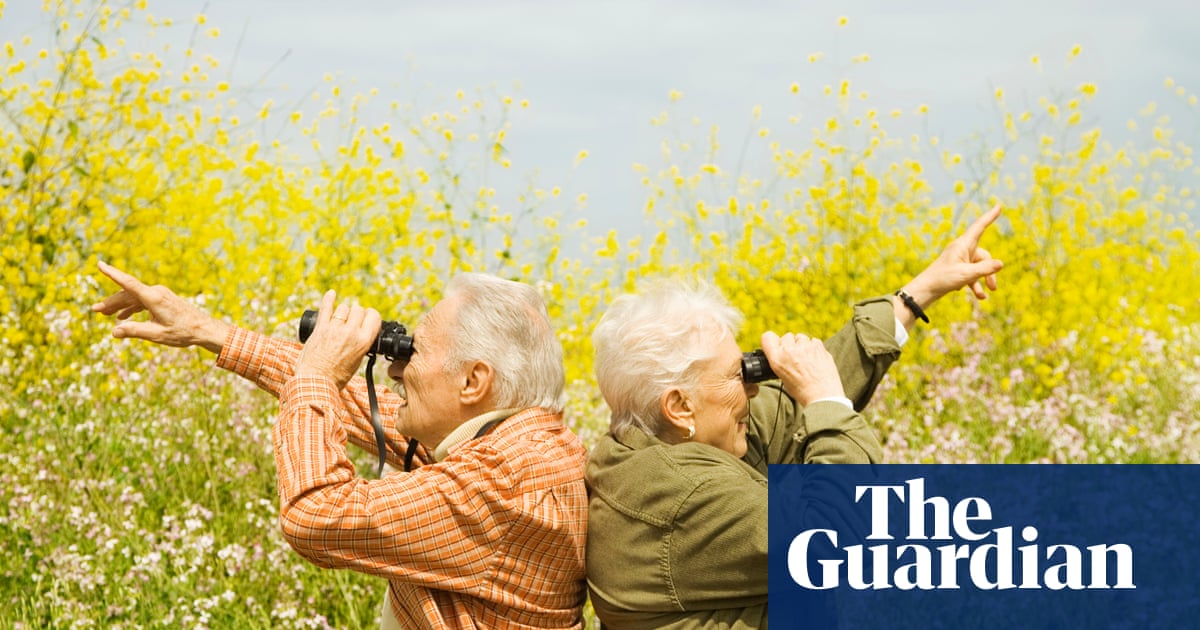They are the most curious creature of all. Hyper-focused. Single-minded. Intense. Devoted. Often single. They speak in reverent tones and hushed whispers and can walk with preternatural silence across a bed of leaves. They wield binoculars with the nonchalance of a sommelier sampling a Dom Pérignon. They can crouch in shrubbery for endless hours. They speak in code and use hand signals. They have lists and notebooks and write with lead pencils. They dress with military precision: khaki pants, fitted belt, cedar-brown shirt, wide-brimmed hat, waterproof boots. Their social calendars are governed by migration patterns and their conversations are peppered with whispered phrases like “Was that the trill of a reed warbler?”
They are bearers of universal mysteries. Holders of ancient wisdom. They are birdwatchers.
Birding isn’t merely a hobby. It’s a lifestyle, like wearing Crocs or having a Goop subscription.
Birders are the world’s most unwavering optimists. They believe, against all odds, that somewhere out there is a bird they have never seen, just waiting to be discovered. And they will keep looking, one step (in a pair of sensible shoes) at a time.
They are dealers in wonder and awe, masters of birds and ecosystems, and, despite the many stereotypes we can muster, one should never underestimate the power, joy and influence of the birdwatcher. Indeed, they may just be humanity’s greatest source of inspiration and hope.
The birdwatcher could be anyone. The kindly neighbour who seems oddly fixated on their back yard feeders. The co-worker who goes mysteriously quiet during meetings every time a shadow flits past the window. They’re everywhere, quietly cataloguing the avian world, one robin or finch at a time.
Birding is an invitation to connect with the natural world in profound and unexpected ways. And while it might start as a solitary pursuit, birding is actually an enormous community of care, a movement rooted in the simple yet transformative act of witnessing and safeguarding the world’s wonders.
Few pastimes inspire more unbridled mockery than birding. It’s the Dungeons & Dragons of the natural world. And birders themselves? They occupy the curious cultural space of being both painfully earnest and entirely incomprehensible to outsiders. There are the “patch birders”, fiercely loyal to their local wetland or park, who catalogue every twig and leaf with near-pathological fervour. Then there are “twitchers” who, upon hearing the faintest whisper of a rare and exotic bird sighting, are conveyed to a fevered delirium; they will abandon weddings, careers and even newborn babies to embark on an intercontinental pursuit for a fleeting glimpse of a golden-winged warbler. There are listers and big listers; back yard birders and urban birders; ear birders, sea birders, competitive birders and social birders.
skip past newsletter promotion
Sign up to Clear Air Australia
Adam Morton brings you incisive analysis about the politics and impact of the climate crisis
Privacy Notice: Newsletters may contain information about charities, online ads, and content funded by outside parties. If you do not have an account, we will create a guest account for you on theguardian.com to send you this newsletter. You can complete full registration at any time. For more information about how we use your data see our Privacy Policy. We use Google reCaptcha to protect our website and the Google Privacy Policy and Terms of Service apply.
after newsletter promotion
They wield binoculars with the nonchalance of a sommelier sampling a Dom Pérignon
Birders are everywhere. Birdwatching, as it turns out, is gloriously addictive.
At its heart, birdwatching is an act of quiet rebellion. It is the gentle act of noticing – the willingness to see the world around you. And this simple act is, in itself, revolutionary. In a world that often teaches us to look past the natural world – to pave it over, cut it down or otherwise ignore it – birdwatching demands slowness and attention. It demands that we pause, that we listen, that we care, that we see.
And it’s never about one single bird. It’s about everything that sustains them. The soil. The trees. The rivers. The wind. Soon, it evolves into understanding the delicate interplay of ecosystems – the leaf litter turned over by superb lyrebirds, the seeds dispersed by cassowaries, the flowers kissed into bloom by honeyeaters. A single bird becomes a prism through which to view the entire ecological web, a window into the world, a thread connecting you to nature.
It’s no longer possible to see a forest as a commodity or a wetland as an inconvenience when these spaces are home to creatures whose existence depends upon them. Birders understand, perhaps better than most, the fragility of the natural world. They see it in the dwindling numbers of migratory birds, in habitats encroached upon by development, in the ghostly silence where once there was song. Yet they also see hope: in the return of the California condor from the brink of extinction, in the rise of the whooping crane after tireless conservation efforts, in the fierce resilience of nature when given the chance to heal.
Photograph: Simon & Schuster
To be a birder is to fall in love. Obsessively, irrevocably and, perhaps, foolishly. This love, it creeps up on you. A wedge-tailed eagle slices through the sky. A magpie’s liquid song pierces the dawn. A snowy owl gazes unblinking across the tundra.
So, here’s to the birdwatchers, those optimistic, slightly eccentric custodians of wonder and joy and passion and love. Because sometimes it is as simple as opening your eyes, stepping outside and looking upon the world around you.
For once you see – once you really see – you cannot unsee. You see the beauty and destruction, the joy and the tragedy of life around you. And you fall in love. And once you are in love, there is nothing you wouldn’t do to protect this fragile, extraordinary world.
This is an edited extract from Nature’s Last Dance by Natalie Kyriacou, out now through Simon & Schuster

